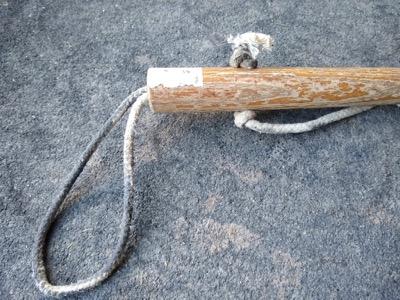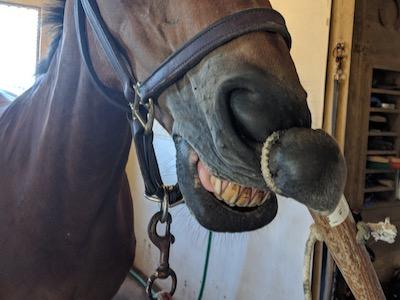The Science of Twitching Horses
My goal for this article is not to create controversy but to outline the reasons for using a twitch (or not) and what types of twitches are appropriate. Twitching horses is not abuse when done correctly with a horse nose twitch. Sometimes, they will keep a horse safer for the short term. However, there are limitations to the effectiveness of the twitch and how long it lasts. And yes, there’s science about this!
Table of Contents

What is a Horse Twitch?
- A twitch is a mechanical way of subduing your equine buddy. There are nose twitch techniques, ear twitch techniques, and even the skin of the neck twitch technique. Nose twitching is the most common and easy to do.
The Horse Nose Twitch
- The nose twitch is usually a section of rope, approximately 10 inches long, looped and tied to a long pole. The rope should be wide-ish and soft, and a traditional lead rope is usually too thick.
- First, place your hand through the loop, then hold the upper lip. Slide the loop over your hand and onto the lip, then tighten.
- Some folks use a more cursory twitch, a loop of baling twine, and a double-ended snap. The twine twists around the horse’s upper lip. The twine is thin and may remove skin, too. I would only use this in extreme emergencies when nothing else is around, and restraint is the safest way to help.
- With this type of twitch, there is NO WAY to safely remove the twitch if attached to the halter and the horse “comes to” and panics. If you must use this type of twitch in an extreme emergency, please do not attach the snap to the halter or metal ring connected to your horse. You won’t be able to undo it if your horse panics.
- You can also use a twitch that is part nutcracker and part very smooth pincher thing. (See option in the shopping section, down below.)

A standard lip loop and wooden dowel.
The horse ear twitch
- This method is a particularly barbaric way of subduing a horse. Essentially, an ear is twisted and pulled. Many horses will become head-shy and sour after this experience, and there’s preliminary science to support the negative nature of this specific twitching practice.
The skin twitch
- Also known as a shoulder roll, this method often helps a horse that is hesitant about injections in their neck. You can grab a specific spot on your horse’s neck, near the shoulder, and gently roll it. Stay on the same side of your horse that the vet is working on if possible. For example, if your vet is on the left side, ideally, you can twitch the left shoulder.
How do twitches work?
- Is it like sedation? The broad answer to this question is that they create endorphins, the feel-good natural chemicals their bodies produce. Think “runner’s high,” but for equines.
- But it’s a bit more complicated. Once a twitch is applied, the horse’s body needs about three to five minutes to ramp up the endorphins. During this time, you might notice some horses become ticked off or agitated.
- As the endorphins kick in, they might “check out” and show signs of relaxation. Eyes may glaze over, and the head and lower lip may drop. This is similar to sedation, but without drugs, and waking up is much faster.
- The endorphins only last for about 10 minutes. If a horse decides to “check back in” while the twitch is on, you may have a feisty ball of flying legs.
This abstract likens the twitch to acupuncture.
I can’t emphasize this enough for nose and skin twitching: Have your vet show you how to do this properly. Don’t just watch a video or read step-by-step instructions; opt for hands-on training instead.
When would you twitch a horse?
- Twitches are typically used during veterinary procedures when a horse needs to be chill for a few minutes but can’t have sedation. During a lameness exam, they can’t be sedated, but if they need to have a quick nerve block during the exam, a twitch is an option. This nerve block procedure stings a bit more than a traditional injection, and accuracy from the vet is vital. The twitch induces euphoria, making the nerve block safer and less painful.
- Other times to twitch might be during an emergency. If a horse is injured and can’t stand calmly for the injection of pain relief and sedation, using a twitch can keep them from hurting themself more. It is extremely dangerous to give medications when there is panic, pain, and thrashing going on. Twitching can give you a window to make it happen.
- Twitching horses provides a small window during which your horse is chilled and relaxed. Yes – relaxed. But only with the non-ear type of restraint! Let’s dive into that part now.
Read this guide to equine emergencies and first aid.

This is one type of nose or lip twitch. I only recommend these if it’s a dire situation. Ideally, the twine or string would be much thicker and softer.
The Science of Twitching Horses
- A few years ago, 12 horses were studied using ear and lip twitches. This sample size is small, but we already know that researchers working with horses often need help finding large groups of horses to participate in. It’s what we have so far, so let’s go with it.
Measuring HR and HRV
- We also know that heart rate (HR), heart rate variability (HRV), and cortisol levels are indicators of stress. Cortisol can be measured from blood or, in this case, from saliva. Increased levels of HR and cortisol indicate stress.
- HRV examines the variations in time between each heartbeat. When horses are stressed, their bodies are primed for the “fight or flight” response. You may be familiar with this during a spook. The HRV during this time is low. A more relaxed horse will have a high HRV.
- OK – back to the study. Some of the horses were twitched on the lip. HR and cortisol levels decreased, while HRV levels increased. They were relaxed!
- However, using the lip twitch for more than five minutes caused the HR levels to rise and the HRV levels to drop, indicating stress.
- The ear twitch used on the other horses produced the opposite effect. No horses showed signs of relaxation, and their saliva and heart rate measurements confirmed this. Weeks later, some of those horses struggled with having their ears handled. Moral of this story: there is zippo relaxation with an ear twitch.
Twitching horses for conditioned pain modulation
- Conditioned Pain Modulation (CPM) is when one painful stimulus makes another, separate pain feel less intense. In other words, it’s the idea that “pain can block pain,” which occurs through complex signaling between the brain and spinal cord.
- Some clever researchers studied using twitches for CPM, and the results in:
In conclusion, based on the current findings, the question of whether lip twitching should be utilized as a conditioning method in CPM studies appears debatable. On one hand, if conditioning is to effectively induce pain, aversive behavioural signs must be inherently tolerated to some extent; on the other, it is imperative to establish stringent cut-off criteria to prevent exposing sensitive individuals to elevated stress and excluding them from testing. Similar considerations should apply to the general use of the lip twitch as a restrain technique in horses.
- This research also details the history of twitching horses, dating back to Greek and Roman times, as well as in many other instances. It also mentions that some horses become sensitized to the horse nose twitch, while others don’t tolerate it at all.
Can you see different horse behaviors while twitched?
- Another endeavor examined how horses respond to twitching and what we can observe, and how those indicators relate to their personalities.
- In summary:
The simultaneous reduction of forward ear positioning during twitching suggests a withdrawal of attention from the environment and a shift towards a negative emotional state, and a certain degree of discomfort could reasonably be assumed to occur during the procedure. In addition, our study revealed reductions in voluntary behaviors, such as ear movements and natural head position during twitching. We also observed a significant decrease in resting of the forelimbs during and after twitching, further suggesting a disruption of relaxed postures typically associated with low arousal states. Similarly, pawing behavior, typically associated with moderate agitation or frustration, was significantly reduced during the Twitch interval, indicating a generalized suppression of active behaviors during restraint. Reduced voluntary behaviors such as decreased ear movements, natural head position and pawing during twitching may be indicative of either temporary coping mechanisms or behavioral inhibitions in response to the restraint.
As initially hypothesized, the present study showed that the lip twitch induced observable behavioral changes consistent with mild stress in the horses (ten out of twelve) that completed the procedure. In contrast, a high level of stress and aversion to the twitch application was observed in the two horses that were excluded.
Helpful hints about twitching horses.
- Be trained by your veterinarian before attempting this method.
- Never twist an ear.
- Some horses will never accept a twitch. Don’t keep fighting for it.
- Never stand in front of or behind a horse while using a twitch. Many horses strike and kick before and/or after the endorphins. You have no reason to end up with a new black and blue tattoo – or worse.
- Use twitches only in veterinary circumstances when your horse needs to relax for a few minutes. They are absolutely NOT a training method to be incorporated into an exercise program.
- Remove it before the endorphins wear off. Most horses have that five-minute window.
- Please keep it safe folks!

This chill horse is wearing a twitch to facilitate numbing a wound before being sutured. The twitch was removed once the numbing meds were in – super fast!
Training as an alternative to twitching horses
- It wouldn’t be surprising to learn that some horses require positive reinforcement training to become comfortable in certain situations.
- Positive reinforcement horse training utilizes rewards to encourage desired behaviors without the need for restraint. When practiced over time, your equine partner will learn that even scary or uncomfortable situations earn rewards, which could be treats. This method of horse training is easy, builds trust, and instills confidence.
- The perfect example is training a horse to stand quietly for the clippers or an injection.
Video

FAQ’s
How does a nose twitch work to calm or restrain a horse?
Nose twitches are applied to the upper lip and are generally considered safer and more acceptable. Ear twitches involve twisting the ear, which can be extremely painful and harmful. Ear twitching is widely discouraged by veterinarians and equine professionals because of the potential for lasting damage and fear.
What are the differences between nose twitches and ear twitches in horses?
A nose twitch works by applying pressure to the horse’s upper lip, which stimulates the release of endorphins. These natural chemicals create a calming, almost sedative-like effect, making it easier to safely handle or restrain the horse during stressful or painful procedures.
Are there any welfare concerns or risks associated with twitching horses?
Yes, misuse of a twitch can cause unnecessary pain, stress, or even injury. Prolonged use can reduce effectiveness and increase the risk of tissue damage. Inexperienced handling may also escalate a horse’s fear or aggression. Welfare concerns are why twitches should only be used correctly, briefly, and when truly necessary.
How long is it safe to use a twitch on a horse?
Most experts recommend limiting twitch use to about 5 minutes. After this, endorphin release tapers off and the horse may become distressed. Prolonged twitching increases the risk of tissue damage and stress, so it should only be used for short, specific procedures.
When should twitching be avoided or not recommended for a horse?
Twitching should be avoided in very young foals, extremely fearful or aggressive horses, or when the procedure will last longer than a few minutes. It should also not replace proper training or sedation. If used incorrectly, it risks harming both the horse and handler.
GO SHOPPING
Stock up here for your horse supplies! As an Amazon Associate, I earn from qualifying purchases, but it’s ZERO extra cents to you. As a Walmart Associate, I earn from qualifying purchases as part of their affiliate plan. I appreciate your support! You can also visit my Amazon storefront here: PEG storefront.
A more traditional type of twitch, which gives you some wing span to stay away from legs, just in case.
This book is a wonderful, step-by-step guide to helping you "clicker train" your horse with positive reinforcement.
Resources
Blum, S., Gisler, J., Dalla Costa, E., Montavon, S., & Spadavecchia, C. (2024). Investigating conditioned pain modulation in horses: can the lip-twitch be used as a conditioning stimulus?. Frontiers in Pain Research, 5, 1463688.
Flakoll, B., Ali, A. B., & Saab, C. Y. (2017). Twitching in veterinary procedures: How does this technique subdue horses?. Journal of Veterinary Behavior, 18, 23-28.
Kellershohn, J. J., Blum, S., Montavon, S., De Sales, N. A. A., Dalla Costa, E., & Spadavecchia, C. (2025). Are indicators of stress and pain recognizable during lip twitch in horses? A behavioral investigation. Journal of Veterinary Behavior.
Lagerweij, E., Nelis, P. C., Wiegant, V. M., & Van Ree, J. M. (1984). The twitch in horses: a variant of acupuncture. Science, 225(4667), 1172-1174.








